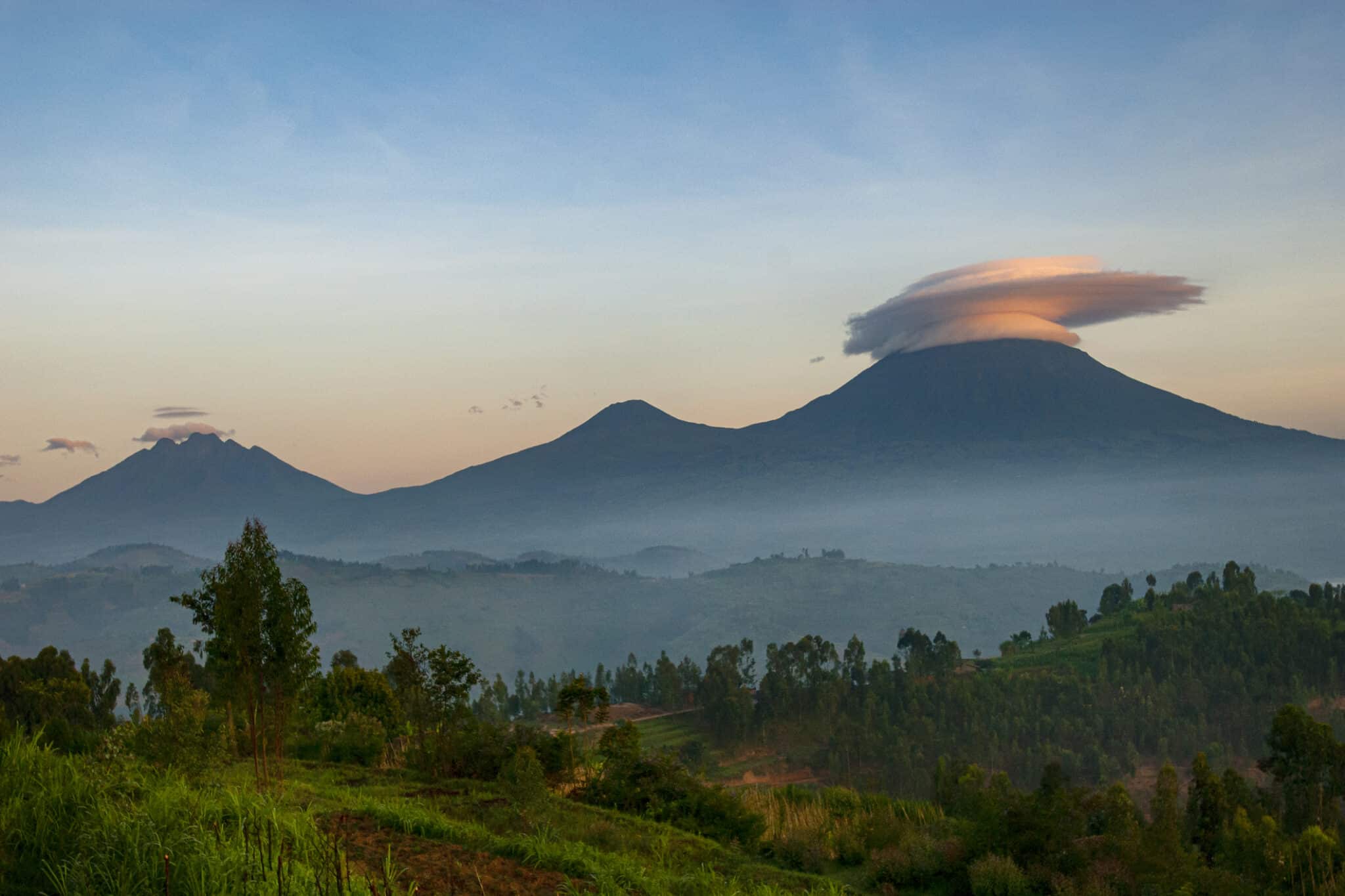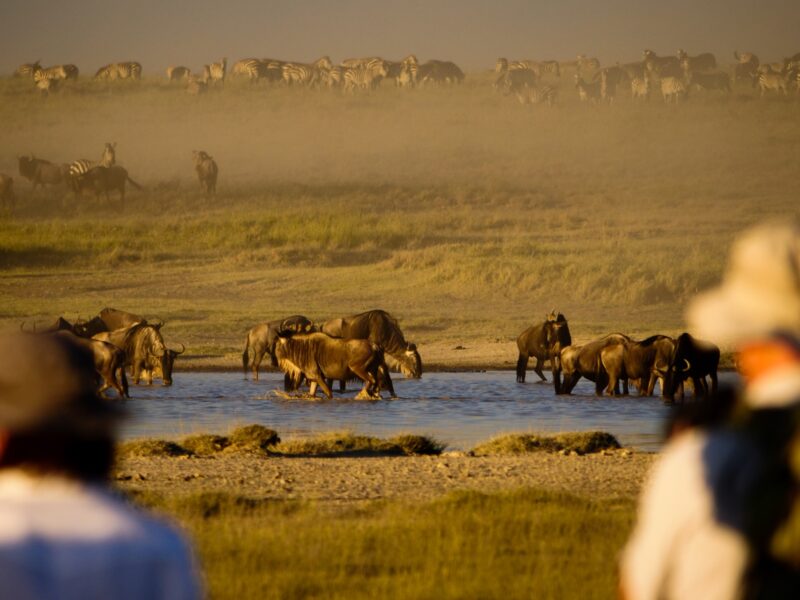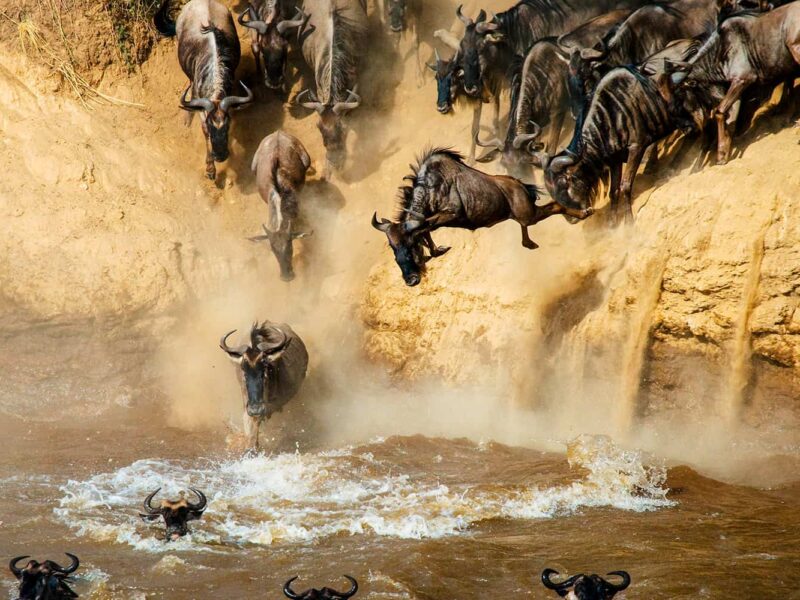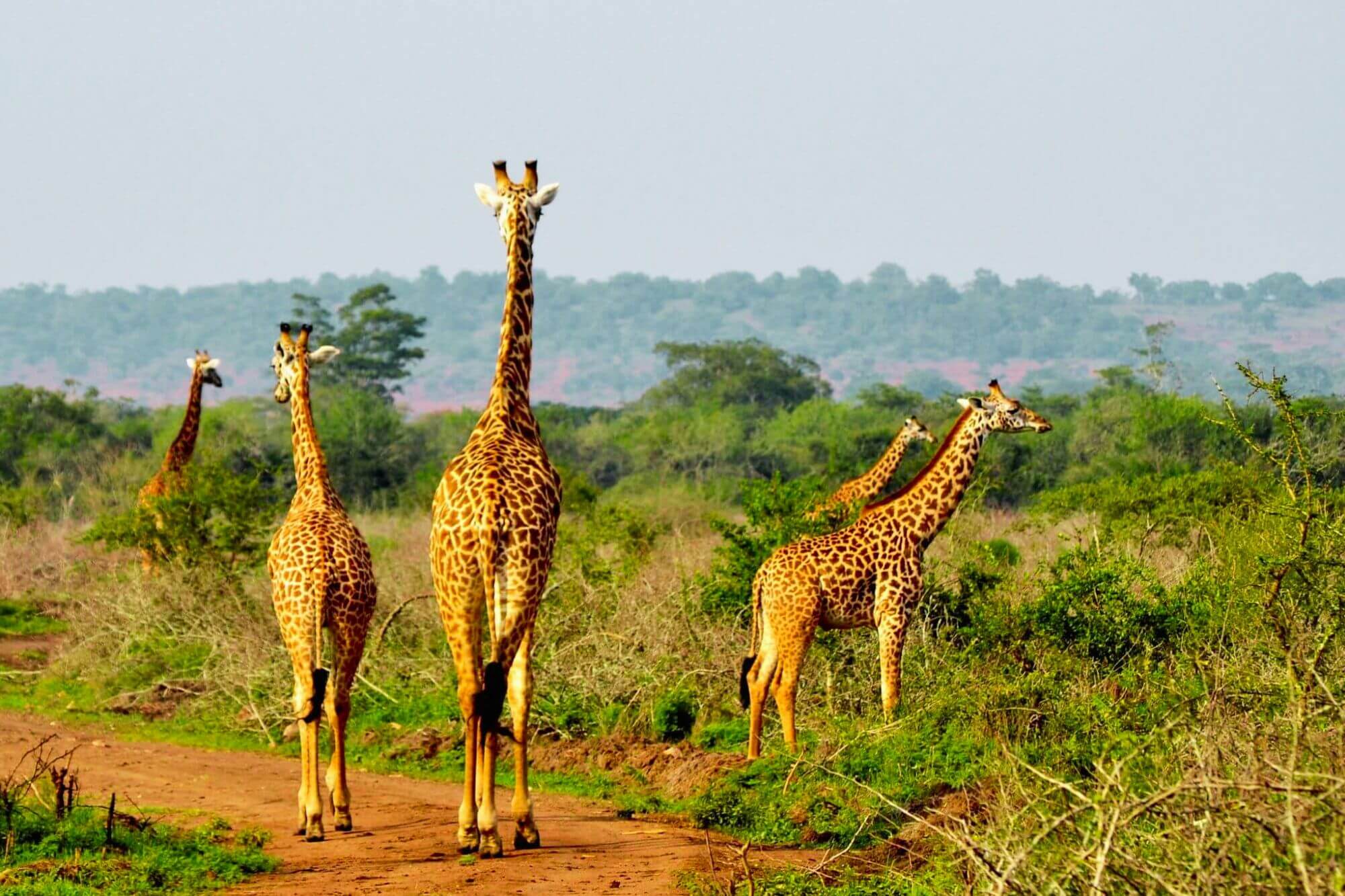
Akagera National Park
April 2, 2025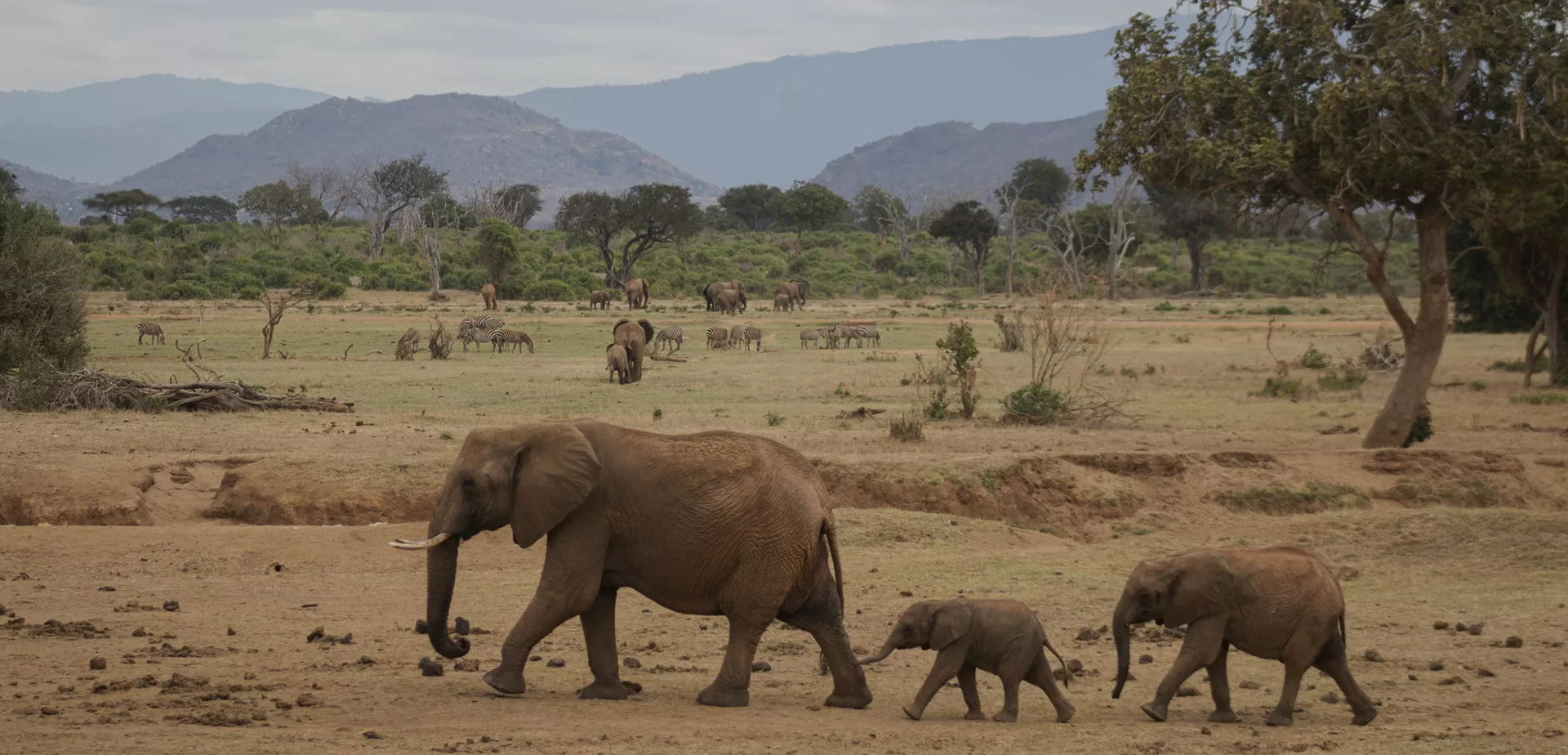
Meru National Park
April 3, 2025View into the mountain range of the Virunga Volcanoes, a line of 8 volcanoes in the area of the border-triangle between Rwanda, Uganda and the DR Congo. Left: Mount Bisoke (3711 m) Middle: Mount Muhabura (4127m) Right: Mount Gahinga (3474 m) The Virunga Volcanoes are home of the critically endangered mountain gorilla (gorilla beringei beringei), listed on the IUCN Red List of Endangered Species due to habitat loss, poaching, disease, and war.
Volcanoes National Park: Rwanda’s Majestic Gorilla Haven
Volcanoes National Park, known as Parc National des Volcans in French, is one of Rwanda’s most iconic national parks. Located in the northwest of Rwanda, near the border with the Democratic Republic of Congo (DRC), and adjacent to Uganda, the park is famous for its stunning landscapes, remarkable biodiversity, and its status as the premier location for gorilla trekking. With its towering volcanoes, lush forests, and rich cultural history, Volcanoes National Park is a must-visit destination for wildlife enthusiasts, adventure seekers, and anyone looking to experience the beauty of Rwanda.
Geography and Location of Volcanoes National Park
Volcanoes National Park, located in the northwestern part of Rwanda, is a stunning region characterized by dramatic landscapes, including towering volcanic peaks, lush forests, and rolling hills. This park is situated within the Virunga Mountains, part of the larger Albertine Rift system, which is known for its geological activity and rich biodiversity.
Geographical Setting
– Location: The park lies in Rwanda’s Musanze District (formerly known as Ruhengeri) in the northwest of the country, near the borders of Uganda and the Democratic Republic of Congo (DRC). It covers approximately 160 square kilometers (62 square miles), making it a relatively compact area but packed with incredible natural beauty.
– Virunga Mountain Range: Volcanoes National Park is part of the Virunga Mountain Range, a series of dormant and extinct volcanoes that stretch across Rwanda, Uganda, and the DRC. This mountain range is one of the most volcanically active regions on Earth, forming part of the East African Rift System, where the Earth’s tectonic plates are slowly pulling apart.
– Altitude: The park is situated at an altitude ranging from 2,400 meters (7,874 feet) to over 4,500 meters (14,764 feet) above sea level, with the highest peak being Mount Karisimbi, which stands at 4,507 meters (14,787 feet). The variation in altitude across the park creates different ecosystems, from dense montane forests to high-altitude grasslands and rocky volcanic landscapes.
Volcanic Features
The park is named for its spectacular volcanic mountains, which dominate the landscape:
1. Mount Karisimbi: The tallest volcano in the Virunga Range, Karisimbi is a dormant stratovolcano that rises majestically above the surrounding forests. It is one of the highest peaks in Rwanda and is often covered with snow at the summit.
2. Mount Bisoke: Standing at 3,711 meters (12,172 feet), Bisoke is a highly active volcano and one of the most popular trekking destinations in the park. It features a crater lake at its summit, adding to its allure.
3. Mount Muhabura: At 4,127 meters (13,540 feet), Muhabura is another active volcano that forms part of the park’s northern boundary. It is the third highest peak in the Virunga Range.
4. Mount Gahinga: Slightly lower at 3,474 meters (11,396 feet), Gahinga is known for its beautiful bamboo forests and is one of the more accessible mountains for trekking.
5. Mount Sabyinyo: At 3,634 meters (11,923 feet), Mount Sabyinyo forms the southwestern boundary of the park and is easily recognizable due to its distinctive jagged peaks. The summit offers stunning panoramic views.
These volcanoes contribute to the park’s rugged topography, with steep slopes, crater lakes, and volcanic craters scattered across the landscape. The presence of these volcanoes has shaped the ecology of the park and its surrounding areas, creating fertile soils that support rich biodiversity.
Surrounding Landscape
– Bamboo Forests: Much of the park’s lower and mid-altitudes are covered by lush bamboo forests, which are particularly prominent on the slopes of Mount Bisoke and Mount Karisimbi. These forests are vital habitats for the park’s famous mountain gorillas and the elusive golden monkeys.
– Montane Forests: Higher altitudes are dominated by montane forests, which feature a mix of tropical and temperate species. These forests provide habitat for numerous species of birds, mammals, and insects. They also help regulate water flow and prevent soil erosion in the region.
– Grasslands and Moorlands: As the altitude increases, the vegetation changes to grasslands and moorlands, especially on the higher slopes of the volcanoes. These areas support fewer species but are nonetheless home to some unique wildlife, including buffaloes and various bird species.
– Crater Lakes: Volcanoes National Park is home to a number of stunning crater lakes, the most famous being the lake on Mount Bisoke’s summit. The blue-green waters of these lakes are surrounded by dense vegetation and add to the scenic beauty of the region.
Climate
Volcanoes National Park experiences a temperate climate due to its altitude, with cool temperatures year-round, making it a pleasant destination for visitors. The climate is characterized by two main rainy seasons:
– Long rains: From March to May, with heavy rainfall.
– Short rains: From October to November.
The dry seasons from June to September and December to February are generally the best times to visit, with more stable weather and drier trails for trekking. However, the rainforests and volcanic terrain can make trekking challenging during the wet months.
Proximity to Nearby Regions
– Musanze: The nearest town to Volcanoes National Park is Musanze (formerly Ruhengeri), located just a short drive from the park’s entrance. It serves as the main gateway for tourists visiting the park, offering accommodation, restaurants, and other facilities. It is also the historical capital of the former Kingdom of Rwanda.
– International Borders: The park is strategically located at the crossroads of three countries—Rwanda, Uganda, and the DRC. This positioning gives it unique geopolitical and ecological significance. The Virunga Conservation Area spans all three countries, making the park part of a broader transboundary conservation initiative to protect the mountain gorillas and other endangered species in the region.
Volcanoes National Park is a stunning blend of geological wonder, rich biodiversity, and captivating landscapes. Its location in the heart of the Virunga Mountains, surrounded by active volcanoes and dense rainforests, creates an awe-inspiring environment. Whether you’re trekking to see the endangered mountain gorillas, exploring its scenic volcanic peaks, or immersing yourself in the rich ecosystem of the park, the geography and location of Volcanoes National Park make it one of Rwanda’s most treasured natural gems.
Wildlife and Biodiversity in Volcanoes National Park
Volcanoes National Park is renowned not only for its stunning volcanic landscapes but also for its rich and diverse wildlife. Situated in the heart of the Virunga Mountains, the park is a biodiversity hotspot, home to numerous species of plants, animals, and insects, many of which are endemic or rare. The park’s unique geographical features, including its altitude, volcanic terrain, and varied ecosystems, support a variety of wildlife that thrives in this protected area.
Here’s a detailed look at the key aspects of the wildlife and biodiversities in Volcanoes National Park:
1. Mountain Gorillas – The Park’s Star Attraction
The most famous and iconic species in Volcanoes National Park is the mountain gorilla (Gorilla beringei beringei), one of the world’s most endangered species.
Mountain Gorillas
– Population: Volcanoes National Park is home toover 300 mountain gorillas, accounting for a significant portion of the world’s total population, which is estimated to be around 1,000 individuals. These gorillas primarily reside in the Virunga Conservation Area, which includes parks in Rwanda, Uganda, and the Democratic Republic of Congo.
– Conservation Success: Thanks to decades of dedicated conservation efforts, including anti-poaching measures, habitat protection, and scientific research, the mountain gorilla population in Volcanoes National Park has steadily increased, turning it into a major conservation success story.
– Gorilla Trekking: Visitors to the park have the opportunity to go gorilla trekking, where they can observe these majestic primates in their natural habitat. Gorilla families, led by a dominant silverback, live in the dense bamboo forests or montane forests of the park. The experience of seeing these gentle giants up close is one of the most memorable wildlife encounters in the world.
2. Golden Monkeys
While the mountain gorillas are the star attraction, the park is also home to another fascinating primate, the golden monkey (Cercopithecus kandti).
– Habitat: Golden monkeys are typically found in the bamboo forests of Volcanoes National Park, particularly on the slopes of Mount Sabyinyo and Mount Bisoke.
– Endemic Species: Golden monkeys are endemic to the Virunga region, meaning they are found nowhere else in the world. Their golden fur and lively nature make them a favorite among visitors.
– Trekking: Like gorilla trekking, visitors can also take part in golden monkey trekking to observe these playful and energetic primates in the wild.
3. Other Mammals
In addition to the iconic gorillas and golden monkeys, Volcanoes National Park is home to a variety of other mammals, although they are less frequently spotted due to the park’s dense forests and rugged terrain.
Buffaloes:
– African Buffaloes (Syncerus caffer) occasionally inhabit the park’s lower regions, although sightings are rare. They prefer the park’s edges and grasslands but tend to stay hidden within the dense vegetation.
Elephants:
– Forest Elephants (Loxodonta cyclotis) are sometimes seen in the park, particularly in the more remote and less-traversed sections. These smaller and more elusive elephants are more common in the neighboring Gishwati-Mukura National Park, but a few may wander into the Volcanoes National Park.
Duikers:
– The black-fronted duiker (Cephalophus nigrifrons) and other species of duikers, a type of small antelope, can be found in the park’s dense forests. These shy animals are often difficult to spot but are an essential part of the park’s ecosystem.
Bushbucks and Other Antelopes:
– Bushbucks (Tragelaphus scriptus) and other species of antelopes, such as the common eland, are also found in the park, although they tend to stay on the edges of the forest and in the more open areas.
4. Birds
Volcanoes National Park is a birdwatching paradise, with over 200 bird species recorded in the park, including several endemic species. Its varied ecosystems—ranging from montane forests to bamboo forests and grasslands—provide a wealth of habitats for diverse birdlife.
Endemic and Notable Birds:
– Rwenzori Turaco (Tauraco johnstoni): A striking bird with vibrant green plumage, the Rwenzori turaco is found in the high-altitude forests of the Virunga Mountains and is endemic to the region.
– African Crowned Crane (Balearica pavonina): Known for its distinctive golden crown and striking plumage, the African crowned crane can be seen in the park’s grasslands and open areas.
– Blue-headed Coucal: A species of bird found in the bamboo forests of the park, the blue-headed coucal is part of the rich avian diversity of the area.
– Buff-throated Apalis (Apalis rufogularis): A small bird endemic to the Virunga region, the buff-throated apalis thrives in the montane forests of Volcanoes National Park.
In addition to these species, birdwatchers can spot other fascinating birds, including the white-necked raven, grey-crowned crane, and a variety of hornbills and sunbirds.
5. Insects and Other Wildlife
Volcanoes National Park also supports a wide variety of insects, particularly butterflies and moths. The park’s diverse habitats and the presence of the volcanoes and forests provide an ideal environment for these smaller creatures.
– Butterflies: Species like the African swallowtail and other brightly colored butterflies are common in the park, particularly in the more open areas and near the bamboo forests.
– Other Insects: The park is also home to various species of beetles, ants, and moths, many of which are not well-documented but are important contributors to the ecosystem.
6. Flora and Plant Life
The park’s diverse vegetation is as important as its fauna. The different altitude zones within the park support a range of plant life, which in turn supports the wildlife living there. Some notable features include:
– Bamboo Forests: Dominating much of the park at mid-altitudes, bamboo forests are home to both the mountain gorillas and golden monkeys. The bamboo is vital for the diets of these animals.
– Montane Forests: Rich in mosses, ferns, and flowering plants, the montane forests are crucial habitats for many bird species and mammals.
– Volcanic Vegetation: The volcanic slopes are rich in minerals and support unique plant species adapted to the harsh conditions of the higher altitudes.
7. Ecological Importance
The Virunga Conservation Area, including Volcanoes National Park, is recognized as one of the most ecologically important regions in Africa. It contains a mix of tropical rainforests, bamboo forests, and grasslands, each playing a unique role in maintaining the biodiversity of the region. These ecosystems provide vital services such as carbon storage, soil stabilization, and water regulation, and they support a range of plant and animal species, some of which are found nowhere else on Earth.
Volcanoes National Park is not only home to the world’s most famous primates—the mountain gorillas but it is also a sanctuary for a wealth of other species, including the golden monkeys, forest elephants, duikers, and over 200 bird species. The park’s biodiversity is a testament to the rich ecosystems that thrive within its varied landscapes, from the lush bamboo forests to the high-altitude volcanic slopes. With its ecological significance and its status as a key conservation area, Volcanoes National Park is a true gem for wildlife enthusiasts and conservationists alike.
Accessibility and Accommodation in Volcanoes National Park
Volcanoes National Park is one of Rwanda’s most visited and accessible parks, making it relatively easy to reach for tourists, particularly those interested in gorilla trekking and other wildlife experiences. The park is located in the northwest of Rwanda, near the border with Uganda and the Democratic Republic of Congo (DRC), in Musanze District (formerly known as Ruhengeri). It’s well-equipped to accommodate the growing number of tourists who come to witness its natural beauty and the mountain gorillas.
Here’s a detailed overview of how to access Volcanoes National Park and the accommodation options available to visitors:
Accessibility to Volcanoes National Park
1. By Air:
– Kigali International Airport (KGL): The closest major airport to Volcanoes National Park is Kigali International Airport, Rwanda’s main international gateway, located about 90 kilometers (56 miles) from the park. It takes around 2 to 2.5 hours to drive from Kigali to the park. International flights from various parts of the world, including Europe, East Africa, and the Middle East, connect directly to Kigali, making it an easy starting point for most visitors.
– Helicopter Services: For those looking for a quicker and more scenic way to reach the park, helicopter transfers are available from Kigali to Musanze. Several companies offer helicopter rides that allow you to enjoy aerial views of Rwanda’s stunning landscapes while cutting down the travel time to around 30-40 minutes.
2. By Road:
– From Kigali to Volcanoes National Park: The drive from Kigali to Volcanoes National Park is relatively straightforward. The road is paved and well-maintained, making it suitable for standard vehicles. Most visitors typically hire a car or book a guided tour with transport included. The journey usually takes between 2 and 2.5 hours, depending on traffic and road conditions.
– Road Conditions: The route from Kigali to the park passes through picturesque rural landscapes, with views of lush hills, terraced farmlands, and small villages. The road is generally in good condition, but it can be winding and hilly as you approach the park, so it’s advisable to drive cautiously.
3. Local Transportation:
– Tour Operators: Many tourists opt to book guided tours through Rwandan tour operators who can provide transportation to and from the park, as well as offer knowledgeable guides for the various activities, such as gorlla tracking. This is a convenient option, especially for those unfamiliar with the region or those looking for an all-inclusive experience.
– Public Transport: While public transport options are available, they are less common for tourists traveling directly to Volcanoes National Park. It’s generally recommended to use private or organized transport for convenience and comfort, especially if you’re planning on trekking or participating in guided tours.
Accommodation in Volcanoes National Park
Volcanoes National Park offers a wide range of accommodation options, catering to different tastes and budgets. Whether you’re looking for luxury lodges, mid-range hotels, or more affordable guesthouses, there are several choices within close proximity to the park entrance.
1. Luxury Lodges and High-End Hotels
For those seeking a more luxurious experience, Volcanoes National Park is home to several high-end lodges that provide a premium stay, often with stunning views of the volcanoes and the surrounding landscape. These lodges typically offer excellent service, fine dining, spa facilities, and easy access to gorilla trekking.
– Bisate Lodge:
– Overview: A luxury eco-lodge located just outside the park, Bisate Lodge is one of the most exclusive accommodations in the region. It offers incredible views of the Virunga Mountains and a unique design inspired by traditional Rwandan architecture.
– Amenities: The lodge features spacious, luxurious villas with floor-to-ceiling windows, private decks, and en-suite bathrooms. It also offers guided treks, cultural experiences, and visits to the Dian Fossey Tomb.
– Price Range: Bisate Lodge is on the more expensive side, making it ideal for travelers seeking a high-end experience.
– Sabyinyo Silverback Lodge:
– Overview: Located near the park’s entrance, Sabyinyo Silverback Lodge offers a luxurious stay with easy access to gorilla trekking. The lodge is known for its charming and comfortable cottages with views of the park and the surrounding volcanoes.
– Amenities: The lodge offers well-appointed rooms, a spa, and a restaurant with both local and international cuisine. Its location makes it a prime spot for those visiting Volcanoes National Park.
– Price Range: While luxurious, Sabyinyo Silverback Lodge provides a more affordable option compared to some of the other high-end lodges.
– One&Only Gorilla’s Nest:
-Overview: Situated in the foothills of the Virunga Volcanoes, One&Only Gorilla’s Nest is another luxury lodge that provides an elegant and exclusive experience. The property is surrounded by nature and offers unparalleled comfort with a focus on sustainable luxury.
– Amenities: This lodge features luxurious suites with private patios, a fitness center, a wellness spa, and gourmet dining experiences. It is also close to the park entrance, making it perfect for gorilla trekkers.
– Price Range: One&Only Gorilla’s Nest is one of the most upscale options in the area, ideal for those willing to indulge in a premium experience.
2. Mid-Range Accommodation
For those looking for a balance between comfort and affordability, Volcanoes National Park has several mid-range options. These accommodations provide good service and comfort without the premium prices of the luxury lodges.
– Mountain Gorilla View Lodge:
– Overview: Situated just outside the park’s boundary, Mountain Gorilla View Lodge is a comfortable mid-range option that offers a relaxed atmosphere and fantastic views of the surrounding volcanoes and forests.
– Amenities: The lodge features spacious rooms with en-suite bathrooms, a restaurant serving local and international dishes, and a bar. It’s a great option for those on a moderate budget.
– Karisoke Guest House:
– Overview: Located near the park’s headquarters in Musanze, Karisoke Guest House is a simpler, more affordable option compared to luxury lodges. It’s also a great choice for those seeking proximity to gorilla trekking departures.
– Amenities: The guesthouse offers basic but comfortable accommodations with all necessary amenities. It’s a great option for those looking for a more budget-friendly stay.
3. Budget and Backpacker Options
For travelers on a tighter budget, there are several guesthouses and budget accommodations in and around the town of Musanze, which serves as the gateway to Volcanoes National Park.
– The Virunga Hotel:
– Overview: Located in the town of Musanze, this budget hotel offers affordable accommodations with basic amenities, making it a good choice for those looking to stay close to the park without spending much on lodging.
– Musanze Backpackers:
– Overview: A great budget-friendly option for travelers, Musanze Backpackers offers dormitory-style rooms and basic amenities. It’s ideal for solo travelers and those looking to meet other adventurers.
Other Amenities and Services
– Gorilla Trekking Permits: To trek gorillas in Volcanoes National Park, you must obtain a gorilla trekking permit, which can be purchased in advance through the Rwanda Development Board (RDB) or through your tour operator. The permit costs around $1,500 per person.
– Guided Tours and Porters: Visitors can hire guides and porters for trekking, ensuring a more comfortable and enriching experience. Guides are knowledgeable and help with locating the gorillas, while porters assist with carrying bags or assisting trekkers during the hike. Volcanoes National Park is relatively easy to access, whether by road or air, making it an ideal destination for those looking to experience Rwanda’s wildlife and stunning landscapes. Visitors can choose from a variety of accommodation options, ranging from luxurious lodges to more budget-friendly guesthouses, all offering easy access to the park and its wildlife activities. Whether you’re looking for an upscale experience or a simple stay, Volcanoes National Park has something to suit every traveler’s needs, making it a top choice for those visiting Rwanda

